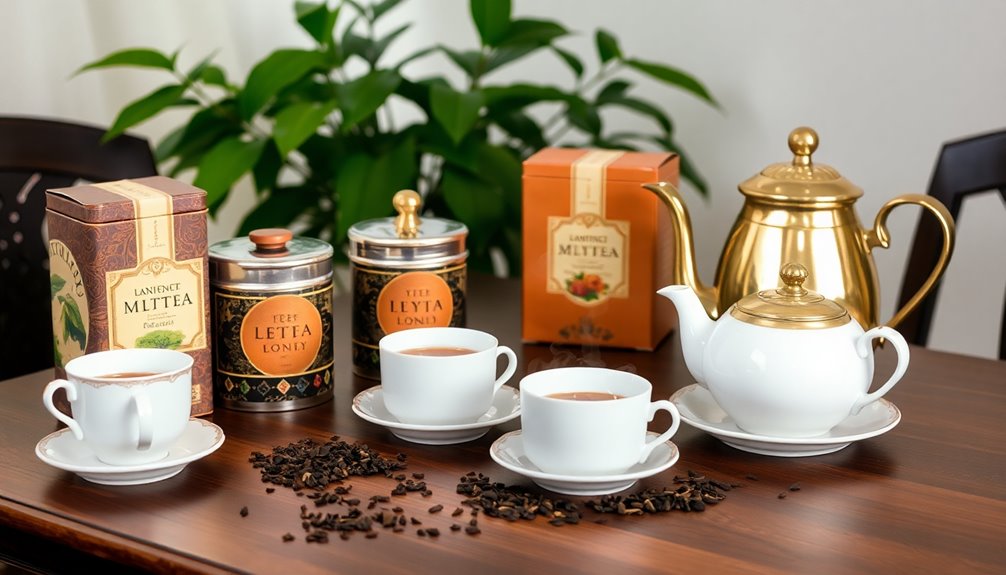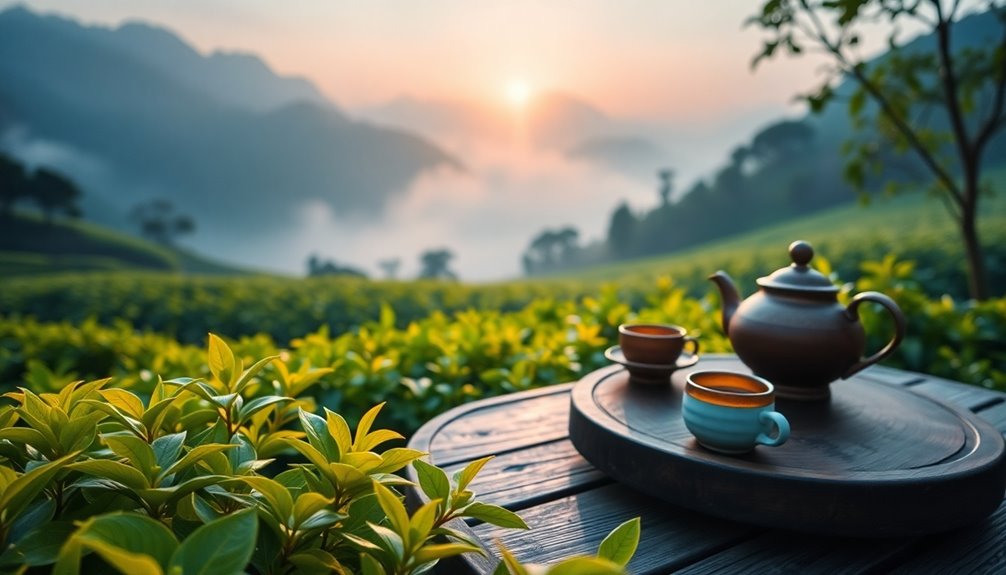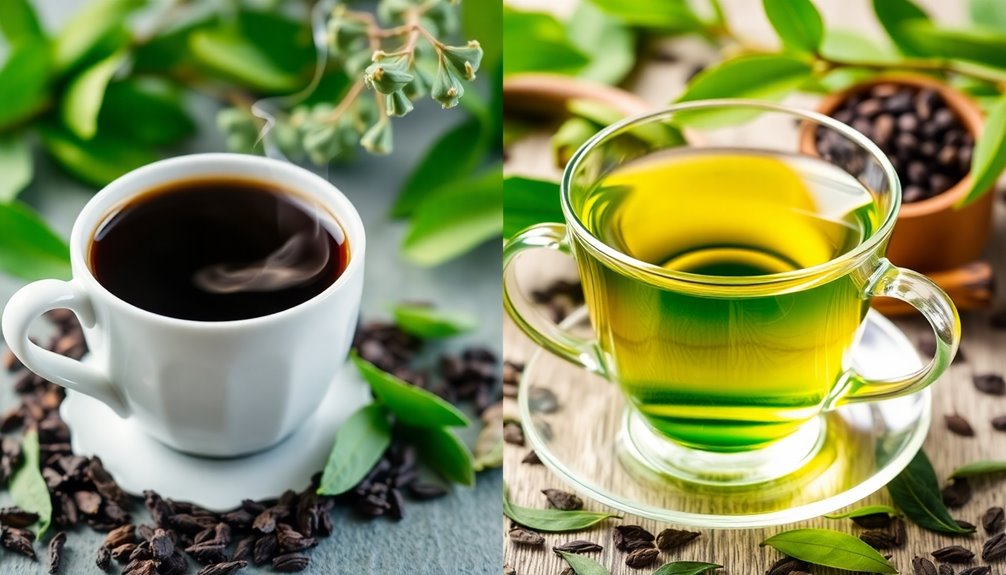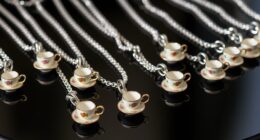Pu-erh tea hails from Yunnan Province, China, and has a history that stretches back to around 225 BC. Over the centuries, it evolved through various dynasties, becoming a treasured trade item during the Tang Dynasty. You'd find it compressed into bricks for easy transport along ancient trade routes, connecting Yunnan with Tibet and beyond. This unique tea also served as currency, making it a valuable asset among traders. Sadly, there are many counterfeit versions out there, so always buy from trusted sources. By exploring this subject further, you'll uncover even more fascinating stories about Pu-erh tea's rich culture.
Key Takeaways
- Pu-erh tea originated in Yunnan Province, China, around 225 BC and has evolved through various historical dynasties, enhancing its cultural significance.
- The tea trade began during the Tang Dynasty, with compressed tea bricks facilitating transport along trade routes to Tibet and beyond.
- Pu-erh became a household staple during the Ming and Qing Dynasties, establishing its status in Chinese culture and society.
- The Old Tea Road allowed Pu-erh to serve as a form of currency, enhancing economic ties between traders and nomadic cultures.
- Counterfeit Pu-erh teas have emerged, highlighting the importance of sourcing from reputable suppliers to ensure authenticity and quality.
Introduction

Exploring the rich history and culture of Pu-erh tea reveals a fascinating journey that dates back to Yunnan Province, China, around 225 BC.
This unique tea has evolved through various dynasties, including the Han, Tang, Ming, and Qing, each contributing to its rich cultural significance. Unlike other black teas, Pu-erh teas undergo an aging and fermentation process that enhances their flavor over time, making them special.
During the Tang Dynasty, Pu-erh tea gained popularity as it was transported along trade routes, becoming a valuable commodity.
There are two main types of Pu-erh: raw (sheng) and cooked/ripe (shou). Each type offers its own distinct flavor profile, which depends on how it's processed.
Cultural practices surrounding Pu-erh tea highlight its quality and age, turning it into a status symbol among collectors and tea lovers, especially in Asia.
If you're curious about the journey of Pu-erh tea or want to explore its diverse flavors, understanding these historical and cultural aspects can deepen your appreciation.
Yunnan's Ancient Tea Trade

Yunnan's ancient tea trade played a crucial role in the development of Pu-erh tea, with roots tracing back to the Tang Dynasty. During this time, tea leaves were first compressed into bricks, making them easier to transport along trade routes. These routes connected Yunnan with Tibetan merchants and eventually led to the famous Silk Road.
Yunnan's strategic location allowed Pu-erh tea to become a valuable commodity, reaching both local and distant markets. One of the important pathways was the Old Tea Road, used by nomads to transport compressed tea cakes. These cakes simplified storage and handling, helping spread the popularity of Pu-erh tea.
Menghai, a key region in Yunnan, became renowned for its rich tea production. This area significantly contributed to the historical tea trade and the development of Pu-erh tea.
During the Ming and Qing Dynasties, Pu-erh tea gained immense popularity. Its unique aging process made it even more desirable, turning it into a staple in households across China.
Yunnan's Tea Trade Routes

The Old Tea Road, instrumental in the tea trade, connected Yunnan with Tibet and beyond, shaping the flow of Pu-erh tea across vast regions. This ancient route allowed traders to transport compressed tea cakes easily.
By compressing Pu-erh tea into cakes or bricks, it became simpler for nomadic traders to carry these valuable commodities on long journeys.
As you explore the history of this trade, you'll find that the routes extended not just to Tibet but also to India and Beijing. Each journey helped Pu-erh tea gain popularity and created a rich exchange of culture and goods.
Merchants and caravans heavily relied on the Old Tea Road, making Menghai a central hub for Pu-erh tea production.
The ease of transport and the long shelf life of these tea cakes contributed significantly to their status as a sought-after item along these trade routes.
Tea as Currency in Trade

Throughout history, Pu-erh tea has played a fascinating role as a form of currency, especially along the famous Tea Horse Road. This trade route connected China with Tibet and beyond, making Pu-erh tea a key player in ancient commerce. Compressed into bricks, this tea was easily transportable, which made it a valuable medium of exchange. Merchants would trade Pu-erh tea for goods like horses and other prized commodities.
One of the reasons Pu-erh tea was so popular in trade was its unique aging properties. As it aged, the flavor improved, and it resisted spoilage better than other goods. This meant that traders could store it for longer periods without worrying about it going bad.
In local markets, you'd see people bartering with Pu-erh tea, reinforcing its status as a prized commodity. Through these trades, Pu-erh tea helped establish economic ties between different cultures. Its value was recognized not just by traders but also by consumers across various regions.
Tea Counterfeit Issues
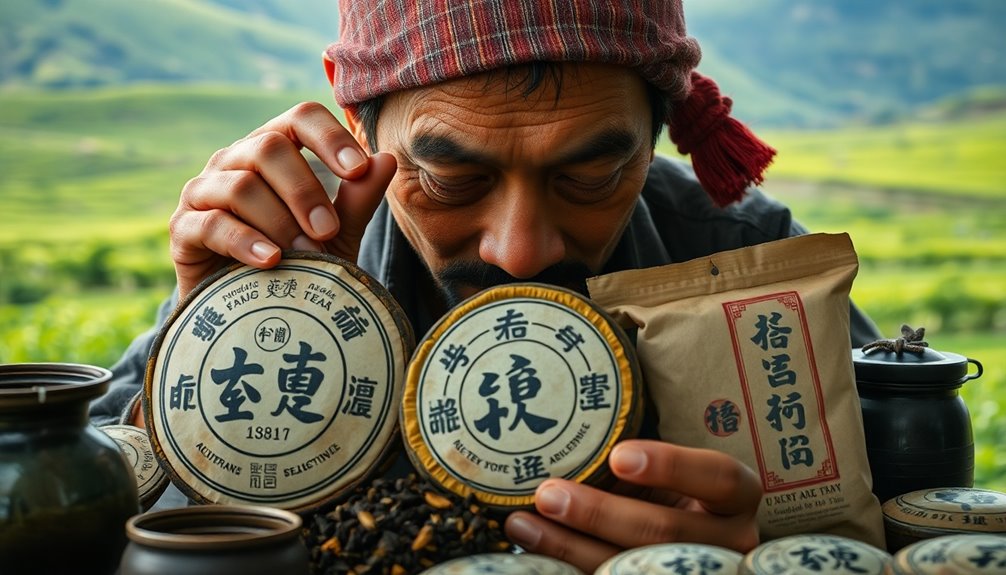
As the popularity of Pu-erh tea continues to soar, counterfeit products have flooded the market, misleading consumers eager to experience its unique flavors and health benefits.
Many of these counterfeit Pu-erh teas aren't even sourced from Yunnan Province, China, where authentic varieties originate. Instead, they often lack the special aging process that gives real Pu-erh its complexity and rich taste.
You might find some of these fake teas blended with low-quality ingredients or artificially flavored, which can ruin the traditional taste and benefits you expect from authentic Pu-erh tea. This misinformation not only confuses tea lovers but also affects the market value of genuine varieties.
To avoid counterfeit products, always buy Pu-erh tea from reputable sources. Look for labels that confirm it's from Yunnan Province, and if possible, choose certified organic options.
Remember, the financial value of rare, aged Pu-erh teas can soar above $10,000. This high demand makes them a prime target for counterfeiters.
Protect your taste buds and wallet by ensuring you're purchasing high-quality, authentic Pu-erh tea that meets the standards you deserve.
Practical Applications

Understanding the authenticity of Pu-erh tea is only the beginning; knowing how to enjoy and store it properly enhances your experience.
When you brew pu-erh tea, use a Yixing teapot or gaiwan with a gongfu style steeping technique. This method allows you to steep the tea multiple times—typically 10 to 12—before the flavor starts to fade. For the best results, steep your tea between 195°F to 205°F (90°C to 96°C), depending on whether it's raw or cooked. This helps bring out its unique flavor profile.
Storing your pu-erh tea is just as important. Keep it in a cool, dry, and odor-free place with minimal air exposure to maintain its aging potential. Remember, only tea from Yunnan province can be called real pu-erh, so always buy from trusted sources.
With so many options available, including unique blends like Coconut Cacao Pu-erh and Dark Chocolate Peppermint Tea, you can explore and find the perfect flavor for your taste.
Whether you're a novice or an experienced tea drinker, diving into the world of pu-erh tea is a delightful journey!
Frequently Asked Questions
What Is the History of Pu-Erh Tea?
You'll find that pu-erh tea's history dates back to around 225 BC in Yunnan, gaining popularity through trade routes. Its unique fermentation process transformed it into a beloved beverage, cherished for flavor and health benefits.
What Is the History of Chinese Tea Culture?
Chinese tea culture, rooted in ancient traditions, evolved through dynasties. You'll find it blossomed during the Tang Dynasty, with tea houses and social gatherings, shaping a rich heritage that emphasizes both enjoyment and ritual.
What Is Special About Puer Tea?
Pu-erh tea's special because it ages like fine wine, developing complex flavors over time. Its unique fermentation process, along with its rare ancient tree origins, offers you a distinctive tea experience that's truly unparalleled.
What Is the History of Tea in Yunnan?
Tea in Yunnan dates back to the Tang Dynasty, where trade began with Tibetan merchants. Over time, the region developed unique black teas, shaping its rich tea culture and establishing Yunnan as a tea hub.
Conclusion
In conclusion, exploring the history and culture of pu-erh tea opens up a fascinating world. You've learned how Yunnan's ancient tea trade shaped its unique routes and even how tea was used as currency! Understanding these aspects helps you appreciate every sip of pu-erh tea even more. So, next time you enjoy a cup, think about the rich history behind it. Dive in, and let the flavors take you on a journey through time!



